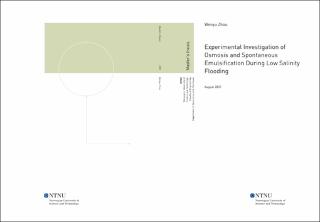| dc.contributor.advisor | Carl Fredrik Berg | |
| dc.contributor.advisor | Lifei Yan | |
| dc.contributor.advisor | Mohammad Hossein Golestan | |
| dc.contributor.author | Wenyu Zhou | |
| dc.date.accessioned | 2021-10-28T17:22:50Z | |
| dc.date.available | 2021-10-28T17:22:50Z | |
| dc.date.issued | 2021 | |
| dc.identifier | no.ntnu:inspera:85047365:46874566 | |
| dc.identifier.uri | https://hdl.handle.net/11250/2826394 | |
| dc.description.abstract | | |
| dc.description.abstract | This experimental study investigates the osmosis and the spontaneous emulsification as oil mobilization mechanisms during the low salinity water flooding by measuring the connate water expansion area in an oil-wet microfluidic system. Two types of synthetical oil, heptane and dodecane, and different salinity brines are chosen to use in the experiments. Meanwhile,
surfactants are added into the oil phase to calculate the water transportation rate due to the
spontaneous emulsification, comparing with the water transportation rate due to the osmosis.
Dynamic light scattering and pendant drop experiments were conducted with the same fluids to
study the spontaneous emulsification process.
The HSW expansion due to the osmosis was observed at the microfluidic experiments with both heptane and dodecane under a salinity gradient. The water transportation rate for the osmosis is as high as the rate for the spontaneous emulsification with enough amounts of surfactants added into the heptane. Insufficient surfactants added may inhibit the water transportation in the synthetic oil. The dodecane shows weaker water transportability in the same condition. It
is still hard to give any conclusion on the effect of the oil viscosity and water solubility. | |
| dc.language | eng | |
| dc.publisher | NTNU | |
| dc.title | Experimental Investigation of Osmosis and Spontaneous Emulsification During Low Salinity Flooding | |
| dc.type | Master thesis | |
